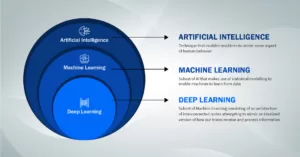Welcome to part one of my three-part blog series–Practical AI, what you need to know.
If you have only been paying a modicum of attention, you might have noticed that recent advances in AI have been shared ad nauseam through social media and technology blogs. With all the information that’s out there, it’s hard to sift through all the details to get a firm grasp on the practical elements of this topic to learn what it might mean for your business. In this three-part series I will be re-introducing you to the field of AI, explore the differences between machine learning and decision optimization, and discuss how to apply cutting-edge AI methodologies at your business.”
Let’s start with some definitions.
AI can be broken down into two subcategories: General AI and Narrow AI. General AI refers to the ability of a system to understand or learn any intellectual task that a human can. As I am writing this, General AI is said to be decades away, and currently serves as nothing more than inspiration for writers of science fiction. Narrow AI on the other hand, is the description of a system that has been created to handle a singular or limited task. An example of Narrow AI is the spam filter on your email inbox: it is designed to take text input from your incoming emails and use this information to determine if this new email is or isn’t spam. You wouldn’t, for example, ask this spam filter to book you a reservation at your favorite restaurant, because the tasks it can perform are limited in scope. Unless discussing future philosophical matters, authors are almost certainly referring to narrow AI when AI is mentioned.
Great, we’re talking about Narrow AI – now what?
Narrow AI can be further broken down into common approaches of accomplishing this intelligence.
Machine Learning for instance is a subset of AI which uses statistical modelling to enable machines to learn from data. The beauty of machine learning is the creator of the system doesn’t need to hard-code any knowledge into the system, the system will learn the necessary elements of its task from the data alone. Applications of machine learning can be found in fraud detection, product recommendation engines, language translation, and self-driving cars to name a few.
What about Deep Learning?
Deep Learning, perhaps the biggest tech buzzword of the past decade, is a subset of machine learning. Despite being commonly spoken about interchangeably with machine learning, it has a very specific technical definition. The creators of Deep Learning took inspiration from a flawed idealization of how our brain reacts to information and attempted to make a similar mathematical model filled with interconnected nodes to have it learn complex tasks. While its genesis is rooted in a flawed premise, deep learning has made waves in the past 20 years due to its success in performing common tasks involving image and natural language data with human-like performance.
This is all fine and well, but how does this help my business?
Practical AI lies in the art of making predictions. If you can formulate your business problem in terms of a predictive task, there is a chance this can be accomplished using AI. What if I want to predict my next-quarter sales? Or predict if one of my customers is a victim of fraud? Or predict if there are faulty products on my assembly line? AI is here to help. In order to gain value from AI you must start with identifying a business problem you want to solve and follow that by defining the outcomes you wish to achieve. The next step is booking a consultation with an experienced Data Science team to iron out the details.
Read part 2: Decision Optimization vs Machine Learning – what’s the difference?
Oliver is a Senior data science consultant helping clients maximize the value of business data. After graduating with a Bachelor of Mechanical Engineering from McGill University, he later went on to study at Georgia Institute of Technology in their Master of Science in Analytics program. Since then, he has been focused on delivering production-ready data science solutions to domains such as manufacturing, engineering, finance, and retail.

